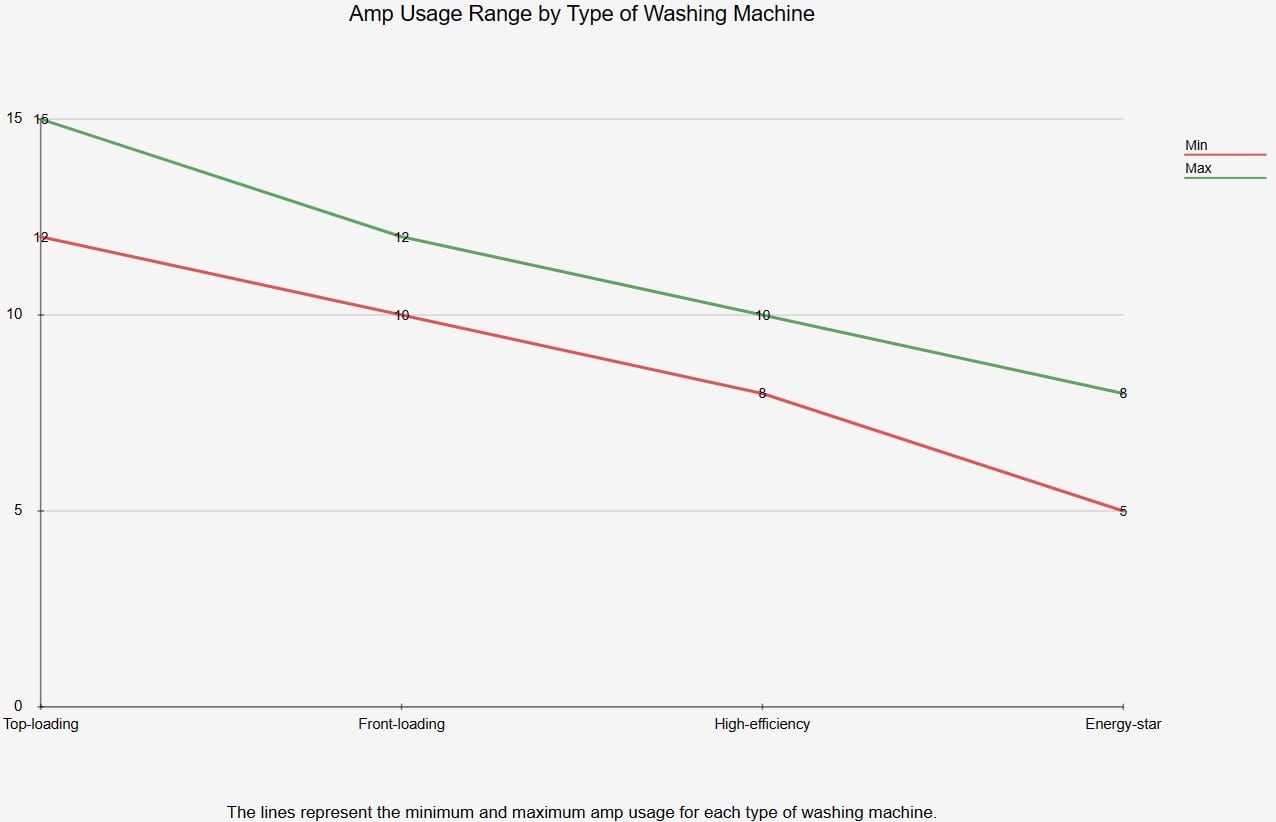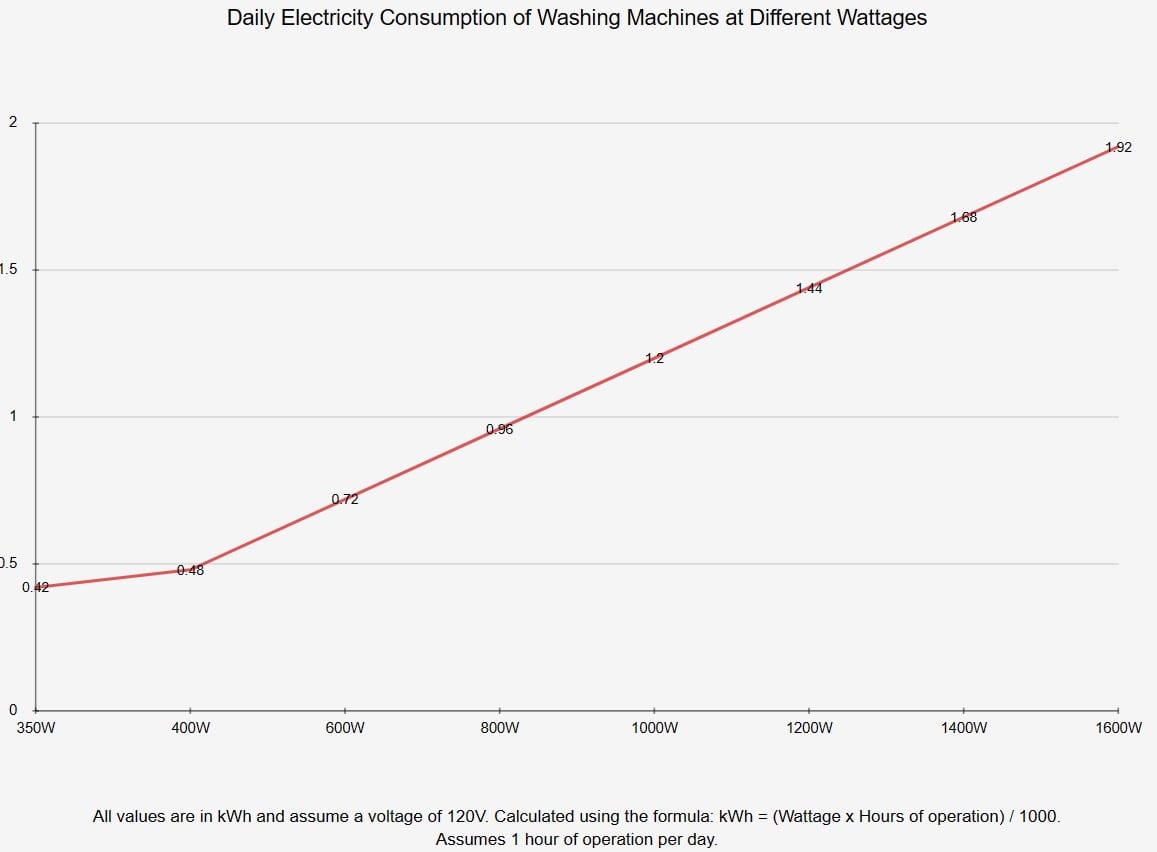Understanding the electrical requirements of your washing machine is crucial for both safety and energy efficiency.
In this article, we will look into key concepts like amps, watts, and circuitry to give you a comprehensive understanding of how your washing machine operates.
Washing machines typically consume between 5 to 15 Amps of electrical current when connected to a standard 120-volt outlet. The amperage can vary based on factors such as wattage rating, washer type, motor size, and the age of the machine. By considering these elements, you can better estimate your washing machine’s amp usage.
Table of Contents
AMPS and Wattage Calculation formula
Suppose you have a washing machine that operates on a standard household voltage of 120 volts (V), and you want to calculate its wattage (W). You measure the current (amperage) drawn by the washing machine and find that it is 5 amperes (A).
To calculate the wattage (power) the washing machine uses, you can use the formula:
W (Wattage)=V (Volts) ×A (Ampere)
Plug in the values:
W=120V×5A
This gives us a wattage value of 600 watts.
So, the washing machine has a wattage of 600 watts. This means it consumes 600 watts of electrical power when it’s running.
Alternatively, if you know the wattage and voltage of the washing machine and want to calculate the amperage, you can rearrange the formula:
A=W/V
Using the same values let’s put this formula to the test::
A (Ampere)=600 (Watts) / 120 (Volts)
By using this formula the calculated amperage is 5A.
A=5A
The washing machine draws 5 amperes of current when it’s operating.
Keep the below formulas in mind in order to calculate the Voltage, Wattage and Amperes:
Calculating Wattage: If you know the voltage (V) and amperage (A), you can calculate the wattage (W) of an electrical device:
W (Wattage )=V(Voltage) XA(Amperes)
Calculating Amperage: If you know the wattage (W) and voltage (V), you can calculate the amperage (A) of an electrical device:
A(Amperes)=W(Wattage)/V(Voltage)
Calculating Voltage: If you know the wattage (W) and amperage (A), you can calculate the voltage (V) across the device:
V(Voltage) = W(Wattage)/A(Ampere)
Wattage and Amp usage for washing machines at different watts and amp
| Washing Machine Power Consumption (Watts) | Amperage (Amps) |
| 350 | 2.92 |
| 400 | 3.33 |
| 600 | 5.00 |
| 800 | 6.67 |
| 1000 | 8.33 |
| 1200 | 10.00 |
| 1400 | 11.67 |
| 1600 | 13.33 |
| 1800 | 15.00 |
| 2000 | 16.67 |
| 2200 | 18.33 |
Rough estimates of average amp usage of different types of washing machines

| Type of Washing Machine | Average Amp Usage |
| Top-loading washing machine | 12-15 amps |
| Front-loading washing machine | 10-12 amps |
| High-efficiency washing machine | 8-10 amps |
| Energy-star washing machine | 5-8 amps |
Difference between Amps and Watts
When it comes to understanding your washing machine’s electrical needs, it’s essential to differentiate between amps and watts.
Amps, or Amperes, measure the electrical current flowing through a circuit. It tells you how much electricity is being used by the device at any given moment.
Watts, on the other hand, represents the rate of energy consumption or production. It is calculated by multiplying the voltage by the amperage.
The main difference between amps and watts is that amps measure the flow of electrical current, and watts measure how much work is being done or energy is being used.
Knowing both the amperage rating and wattage of your washing machine can help you make more informed decisions about its energy efficiency and power consumption.
Can a Washing Machine Run on a 15 Amps Circuit?
The compatibility of your washing machine with a 15-amp circuit largely depends on its amperage rating. Here’s a breakdown:
- 10 Amps Washers: Machines that require more than 10 Amps but less than 15 Amps can comfortably run on a 15 Amps circuit. These are usually energy-efficient models and are less likely to cause circuit breaker tripping.
- 15 Amps Washers: Washers that require up to 15 Amps can also run on a 15 Amps circuit, but it’s essential to ensure that no other high-consuming appliances are connected to the same circuit to avoid washing machine overloading.
- 20 Amps Washers: Machines requiring up to 20 Amps should not be connected to a 15 Amps circuit. These washers usually have higher power consumption and may require a dedicated circuit for safe operation.
Understanding the amperage requirements of your washing machine is crucial for electrical safety and to prevent overloading.
Always refer to your washing machine manual for specific electrical guidelines.
Factors Determining Wattage and Amp Usage
Understanding the wattage and amp usage of your washing machine is not as straightforward as it may seem.
Several factors come into play, affecting both the power consumption and electrical current requirements.
- Motor Power: The motor power is a primary determinant of the machine’s wattage. Higher-powered motors generally consume more electricity.
- Cycle Type: Different wash cycles like delicate or heavy-duty may require varying amounts of power and current.
- Water Temperature: Heating water for warm or hot cycles significantly increases energy consumption.
- Drum Size: Larger drums may require more power to rotate, affecting both wattage and amps.
- Spin Speed: Higher RPM (Revolutions Per Minute) during the spin cycle consumes more power.
- Additional Features: Features like steam cleaning or built-in water heaters can increase the machine’s wattage.
- Control Panel: Digital control panels may consume more power than manual dials.
- Pump: The water pump used during the spin cycle can also affect power consumption.
- Agitator Type: Different types of agitators may consume varying amounts of power.
- Duration: Longer wash cycles will naturally consume more power and current.
- Efficiency: Energy-efficient models generally consume less power.
- Voltage: The voltage at which the machine operates directly affects its amperage rating.
- Motor Efficiency: More efficient motors can often perform the same work with less current, contributing to energy efficiency.
- Start-up Surge: Motors often draw more current during start-up, which can affect the circuit breaker.
- Load: The amount of laundry can affect the motor’s workload, thus affecting the current draw.
- Electrical Components: Sensors, timers, and other electrical components can also draw current.
- Variable Speed Drives: Some modern machines adjust motor speed, affecting amp usage.
- Quality of Components: Higher-quality electrical components may draw less current.
- Software: Advanced washing machines may have software that optimizes energy usage.
- External Factors: Voltage fluctuations and temperature can also affect amp usage.
- Energy Saving Modes: Some machines come with modes specifically designed to minimize current draw, contributing to washing machine energy efficiency.
Understanding these factors can help you make an informed decision about your washing machine’s electrical needs.
Average Electricity Consumption of Washing Machine
Understanding the average electricity consumption of your washing machine is vital for managing your utility bills and promoting energy efficiency.
General Consumption Range
Washing machines generally consume between 350-1,600W of electricity and operate on 6-14 amps when connected to a standard 120V outlet.
The wattage and amperage can vary depending on the model and its features.
Frequency of Use
The frequency with which you use your washing machine has a significant impact on its electricity consumption. For instance, an 880W machine has the following consumption rates:
- Using it once a week: Consumes 0.88 kWh per week, which translates to 3.8 kWh per month and 45.6 kWh per year.
- Using it three times a week: The consumption jumps to 2.64 kWh per week, 11.4 kWh per month, and 136.8 kWh per year.
- Using it daily: In this case, the machine would consume 6.16 kWh per week, 26.7 kWh per month, and a substantial 320.4 kWh per year.
Table Showing Washing Machine Electricity Consumption at different wattages
Here’s a table showing the daily electricity consumption of washing machines at different wattages, assuming a voltage of 120V and 1 hour of operation per day:
| Wattage | Daily Consumption (kWh) |
| 350W | 0.42 |
| 400W | 0.48 |
| 600W | 0.72 |
| 800W | 0.96 |
| 1000W | 1.20 |
| 1200W | 1.44 |
| 1400W | 1.68 |
| 1600W | 1.92 |

The values are calculated using the formula:
kWh=Wattage×Hours of operation/1000
Also Read: How to Calculate Power Consumption of Washing Machine?
Circuitry and Safety
Ensuring the correct circuitry and circuit breakers for your washing machine is not just a matter of efficiency but also of safety.
Importance of Using the Correct Circuitry and Circuit Breakers
Using the appropriate circuitry ensures that your washing machine operates within its electrical specifications, reducing the risk of overload protection failure and electrical safety hazards.
It’s advisable to have a dedicated circuit for your washing machine to prevent overloading and tripping the circuit breaker.
Risks of Using Incorrect Circuitry
Incorrect circuitry can lead to several problems, including:
- Washing Machine Overloading: This can cause the circuit breaker to trip frequently, disrupting the machine’s operation.
- Electrical Fires: Incorrect circuitry increases the risk of electrical fires, posing a significant safety hazard.
- Reduced Lifespan: Operating the machine on an incorrect circuit can reduce its lifespan and efficiency.
- Violation of National Electrical Code (NEC): Using incorrect circuitry may also be a violation of the National Electrical Code, which could result in penalties or void your machine’s warranty.
Practical Tips for Consumers
- Energy-Saving Modes: Many modern washing machines come with energy-saving modes that reduce electricity consumption. Make use of these features whenever possible.
- Cold Water Cycles: Opt for cold water cycles to save energy on heating. Most detergents work just as effectively in cold water.
- Run Full Loads: Running your washing machine with full loads maximizes its energy efficiency. This way, you get the most cleaning done for the least amount of energy.
- Regular Maintenance: Keep your washing machine clean, organized, and in good working order. A well-maintained machine runs more efficiently, saving you both energy and money in the long run.
- Off-Peak Hours: Some utility companies offer lower rates during off-peak hours. Running your washing machine during these times can save you money.
- High-Efficiency Detergents: Use high-efficiency detergents that require less water and, consequently, less energy to heat that water.
- Spin Speed: If your washing machine has adjustable spin speeds, choose a lower speed to reduce energy usage.
Using Extension Cords Safely with Washing Machines
If you must use an extension cord, ensure it is of high quality and has an adequate amperage rating.
Never daisy-chain extension cords as it poses a significant electrical safety risk.
Special Cases
Washer-Dryer Combos
Washer-dryer combos are convenient but often have different electrical requirements.
They generally consume more electricity and may require a dedicated circuit.
Electrical Requirements for Modern, High-End Washing Machines
High-end washing machines, particularly those with smart features, larger capacities, or specialized cycles, often have unique electrical requirements. These may include:
- Higher Amperage: Some high-end models may require circuits with higher amperage ratings, necessitating a dedicated circuit for safe operation.
- Smart Features: Machines equipped with smart technology may have additional electrical components like Wi-Fi modules, which can slightly increase power consumption.
- Variable Speed Motors: Some modern machines come with variable speed motors that adjust according to the load, affecting both wattage and amp usage.
- Built-in Heaters: Models with built-in water heaters will consume more electricity and may require specialized electrical outlets.
- Energy-Efficient Models: While high-end, these machines often come with Energy Star ratings, indicating better energy efficiency compared to standard models.
- Voltage Requirements: Some imported or specialized models may have different voltage requirements, necessitating a voltage converter or a special electrical outlet.
Final Thoughts
Different brands have models with varying electrical requirements.
For instance, an LG washing machine may offer energy-efficient cycles, while a Kenmore washing machine might excel in quick washes that consume less electricity.
Whirlpool washers are known for their reliability and often have energy-saving features.
On the other hand, Samsung washing machines often come with smart technology that can help you monitor energy usage in real time.
Understanding your washing machine’s electrical requirements is not just a matter of efficiency but also a critical safety concern.
From knowing the difference between amps and watts to calculating your machine’s energy consumption, being informed can save you both money and potential hazards.





